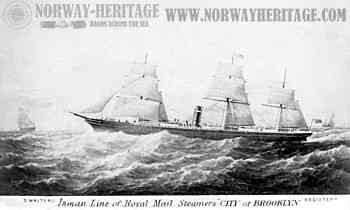I got to know Ellen Gibbons–Mrs. Frank Barrett, my great-grandmother–through stories my mother told. The few photos of her show her frowning, her white hair in a tight bun. A dissatisfied woman. She manages to “un-frown” when holding her first grandchild Mary Margaret, above.

Like many Irish girls from the poor county of Mayo, she set off on her own to America for work and the potential of a husband. Her ship, the City of Brooklyn, docked September 25, 1871, and she made her way to the Irish enclave in Chicago.

No sooner had she arrived in Chicago, the city burned down. The Great Chicago Fire of Oct 8-10 left 100,000 people homeless.
She got the hell out of there. At age 20, she headed for St. Louis.
In St. Louis, she worked as a domestic for retired shoe manufacturer August Knight on Lucas Avenue (or at least that’s where she was at the 1880 Census).
At age 30, she finally met her man, bachelor-farmer Frank Barrett. How this rural fellow met up with citified Ellen is a mystery. But marry they did. She moved from her lodging at the posh Knight home to a log cabin on the Barrett family farm in Catawissa, Missouri. If Ellen had wanted a household of her own to organize, she was out of luck. Her mother-in-law ruled the roost there. My mom wrote me this:
I knew that my grandmother had quite a few miscarriages and I think one died a short time after birth. She told my mother that every time Frank hung his pants on the bedpost she would get pregnant. Also, I think some of the miscarriages happened in Catawissa. She hated the place — and her mother-in-law, because she made Ellen do chores to “save the men” and also she had to go sidesaddle to church every Sunday, which she didn’t care for.
email from KBPrice, 2005
In the 1890s, with three children and another on the way, Ellen put her foot down. Frank gave up farming and they moved to St. Louis. Frank found work as a night watchman.
But Frank dropped dead of a heart attack in 1899. Ellen was 48.
Frank died in St. Louis but was buried in Catawissa. He has a single tombstone there. But Ellen wanted no part of that and had told my father [her eldest Thomas] that she wanted to be buried in his St. Louis plot.
email from KBPrice, 2005
Ellen’s two eldest children, her sons Tom and Francis, were 16 and 15 when Frank died. My future grandfather Tom was in high school on a scholarship. She made the boys quit school to support her and their sisters. It was a bitter pill for Tom to swallow but his mother would have it no other way.
Tom took his obligation seriously and went to work as a shipping clerk. Within ten years, he owned his own grocery store on Easton Avenue and was able to house his family in the apartment upstairs. Francis also got into the grocery business, on a less ambitious scale.
Within a couple years, as Tom started his own family, he bought his mother and siblings a home at 4152 Lexington Avenue. Here, Ellen could have vegetable gardens and raise chickens.
Ellen’s two girls were also sent into the workforce early on. Each had a career. Mary Ellen (aka Mamie) was a commercial seamstress and rose to managerial positions. Catherine (aka Katie) became a stenographer in an optometry office.

Katie didn’t marry Chas Dyer till she was 34, the year before Ellen died. After Ellen died, when Mamie was 45, she married Mickey Coleman and they continued living in the Barrett family home on 4152 Lexington. Neither daughter had children.
Ellen died when my mother was six, but Mom’s direct memory of her grandma was sweet.
I think she must have been a very interesting woman. She had quite a few sayings about everything. My main memory of her is sitting on her lap in a rocking chair while she would tell stories and sing.
email from KBPrice, 2005
I’m searching for an ending. A moral to the story. First, you are only remembered by the stories people pass on about you, plus a smattering of facts and the rare photo. Nearly ninety years after her death, we see Ellen as demanding and judgmental, a woman who wanted to be in charge of her own world.
And we see another variation on women’s resiliency. Her hatred of the prosperous family farm and 1890’s move St. Louis, followed by Frank’s death, resulted in sudden poverty.
I looked in the mirror and tried to reproduce her terrible frown. I could only do it if I clenched my jaw and pressed my tongue into the roof of my mouth. Fear. Rigid determination against loss of control. In demanding her sons quit school to support the family, she made her terrible choice. She pushed her daughters into work, not marriage. Men were unreliable. Don’t make the same mistake I did.
Ellen Gibbons Barrett died in 1931. She outlived her son Tom, but was buried next to him at Calvary Cemetery in St. Louis, Section 24, Lot 111.


Sheesh – I always wondered about that frown. One thing I know for sure, it’s good to have storytellers. Luckily, we have you.
LikeLike